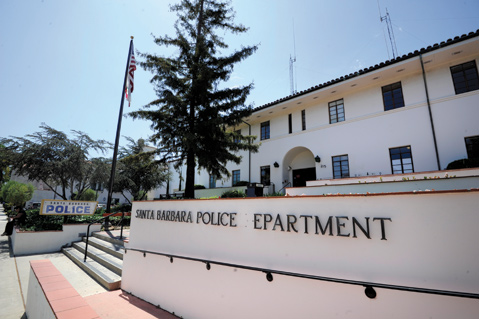Police Station a ‘Sick Building’?
Cancer Incidents Cause Concern Over the Outdated Headquarters

The California Division of Occupational Safety and Health (known as Cal/OSHA) has now conducted two inspections of the Santa Barbara Police Department’s Figueroa Street police station, the most recent inspection taking place this Tuesday. Cal/OSHA spokesperson Erika Monterroza confirmed that the state safety agency is investigating the police station, but she declined further elaboration explaining that to do so might “corrupt” the results. She did say that the investigation was initiated on February 26 and that by law, her agency has six months to complete the job.
Sergeant Mike McGrew, long the face of the Police Officers Association (POA), said he instigated the investigation after ambient tests for potential carcinogens that had been promised in December by Police Chief Cam Sanchez were not conducted. According to McGrew, the chief pledged at a leadership meeting to have the tests performed. When he checked with department brass to determine if the tests had been done in February, he was informed they had not. He then called Cal/OSHA and notified his superiors within the department that he had done so. The tests were conducted not long after, said assistant chief Frank Mannix. Those tests revealed, he said, no apparent health risks posed by the building.
Mannix and McGrew said they were animated by concerns that the police station might be a “sick building.” A number of department employees — or recent retirees — have either died of cancer in recent years or gotten sick with the disease. Mannix cited two recent deaths and about five nonfatal cancer incidents. Further fueling such concerns was the extensive work refurbishing the building’s heating, ventilation, and air conditioning (HVAC) system that began earlier this year. “It’s been like being in a dental office on steroids,” said Mannix. That work has proved disruptive to departmental employees, and the dust, sawdust, and particulate matter — from drywall and cottage-cheese ceiling materials — have exacerbated employee fears about unsafe working conditions.
Mannix took exception to suggestions that Police Department brass didn’t take the issue seriously. “The tests happened in the first place because Chief Cam Sanchez was committed to having them done,” Mannix declared. “They didn’t take place because of Mike McGrew or the POA.” Mannix noted that Sanchez had obtained funding approval from former city administrator Jim Armstrong to pay for the tests — about $10,000 — and subsequently got the green light from Armstrong’s successor, Paul Casey. McGrew stated the ambient tests did not occur until after he called Cal/OSHA.
Mannix said City Hall Risk Management personnel conducted two briefings with police employees notifying them that the test results did not reveal the presence of environmental carcinogens at levels sufficient to cause health problems. At those meetings, he said, several employees questioned whether radon levels had been tested, as well. They had not. “We ordered those tests, as well,” Mannix said. Those tests are scheduled to be conducted sometime later this month.
Chief Sanchez was in Oakland attending a funeral for a police officer killed on duty and was not available for comment.
Another issue noted by McGrew was the absence of a decontamination station in the police station. Typically, such stations are required so that officers can scrub blood and other bodily fluids off their boots and clothes before entering the shared public areas in the police station. The station house — built in 1959 and widely viewed as outdated in the extreme — instead has an eye-wash station. Mannix said the building has a restroom that opens to the exterior of the building that’s open “24/7” and functions as a decontamination chamber, allowing officers to clean any blood off prior to entering public areas. He acknowledged, however, that the room itself may not be labeled in accordance with Cal/OSHA guidelines, likewise the antibacterial soaps provided.
Replacing the station house has long been at the top of City Hall’s to-do list, but the $70 million required to build a new one has proved cost prohibitive. A bond measure in 1999 to raise the funds needed — then only $25 million — failed miserably with city voters. A majority of the City Council had hoped to place a bond measure on the November ballot this year to raise the funds needed to rebuild or seismically retrofit the police station — as well as a host of other unmet infrastructure needs — but the council was unable to achieve the 5-to-2 supermajority needed to put the matter on the ballot so voters could decide.


